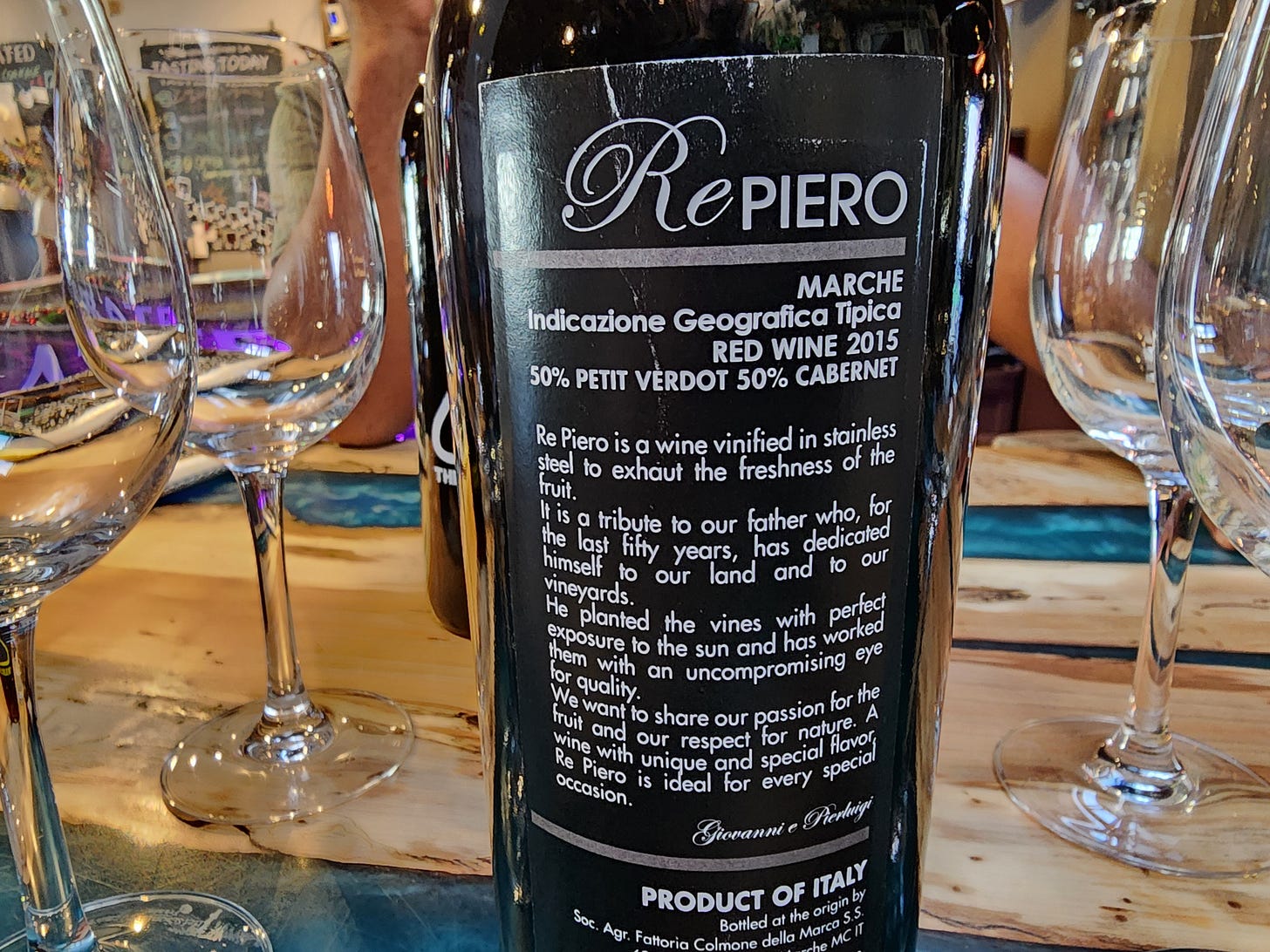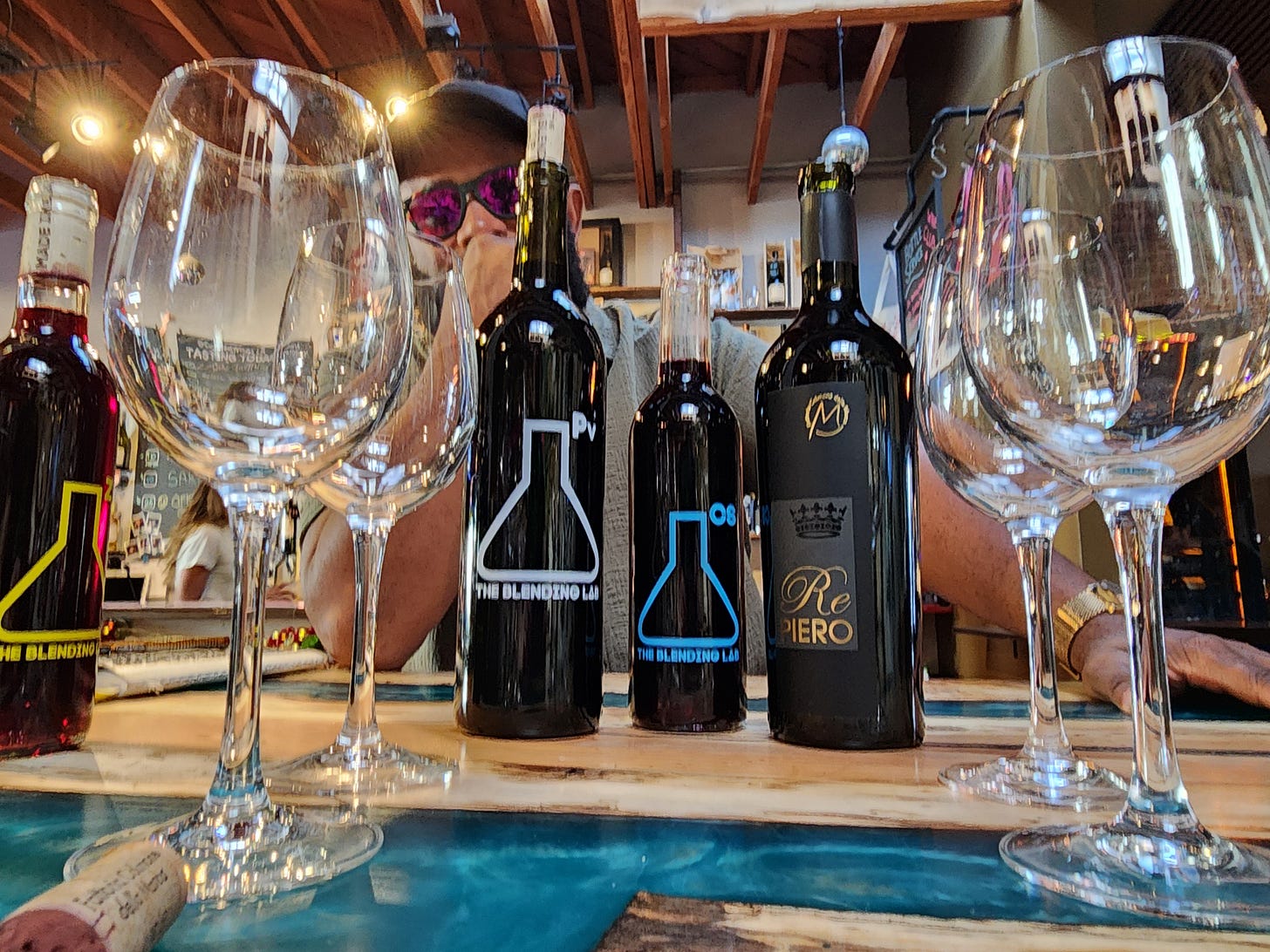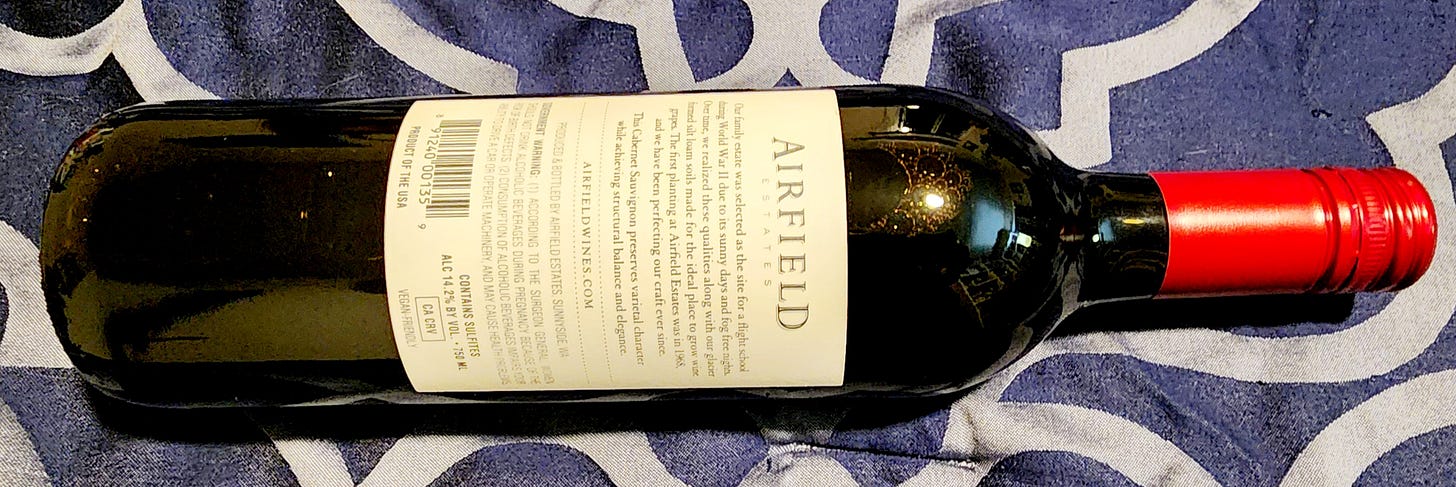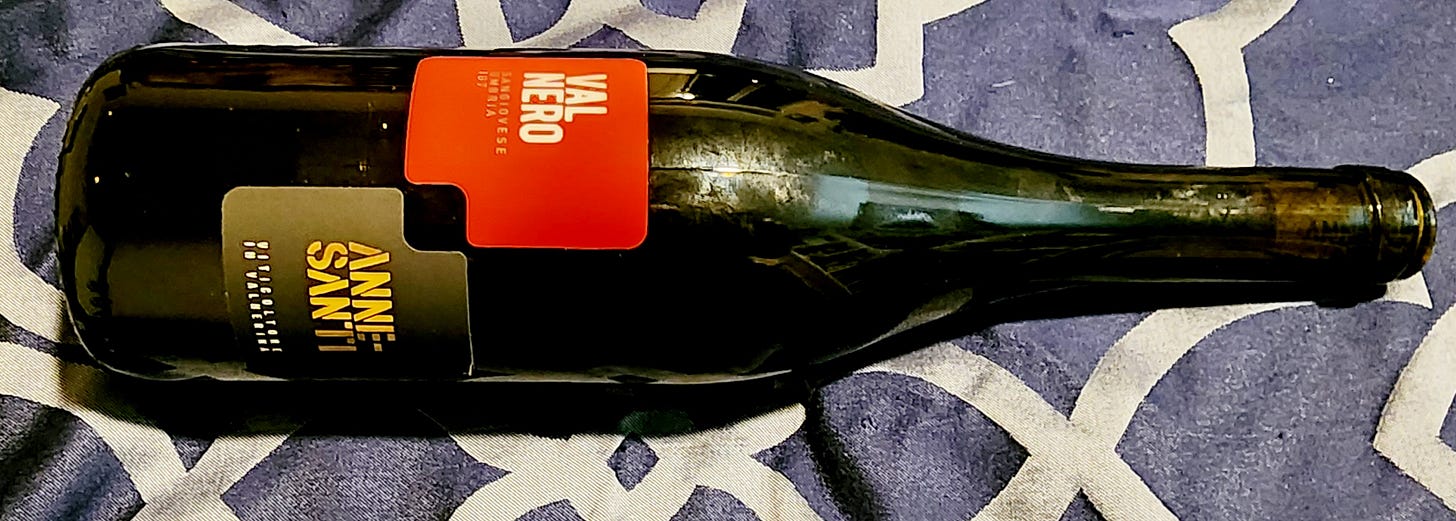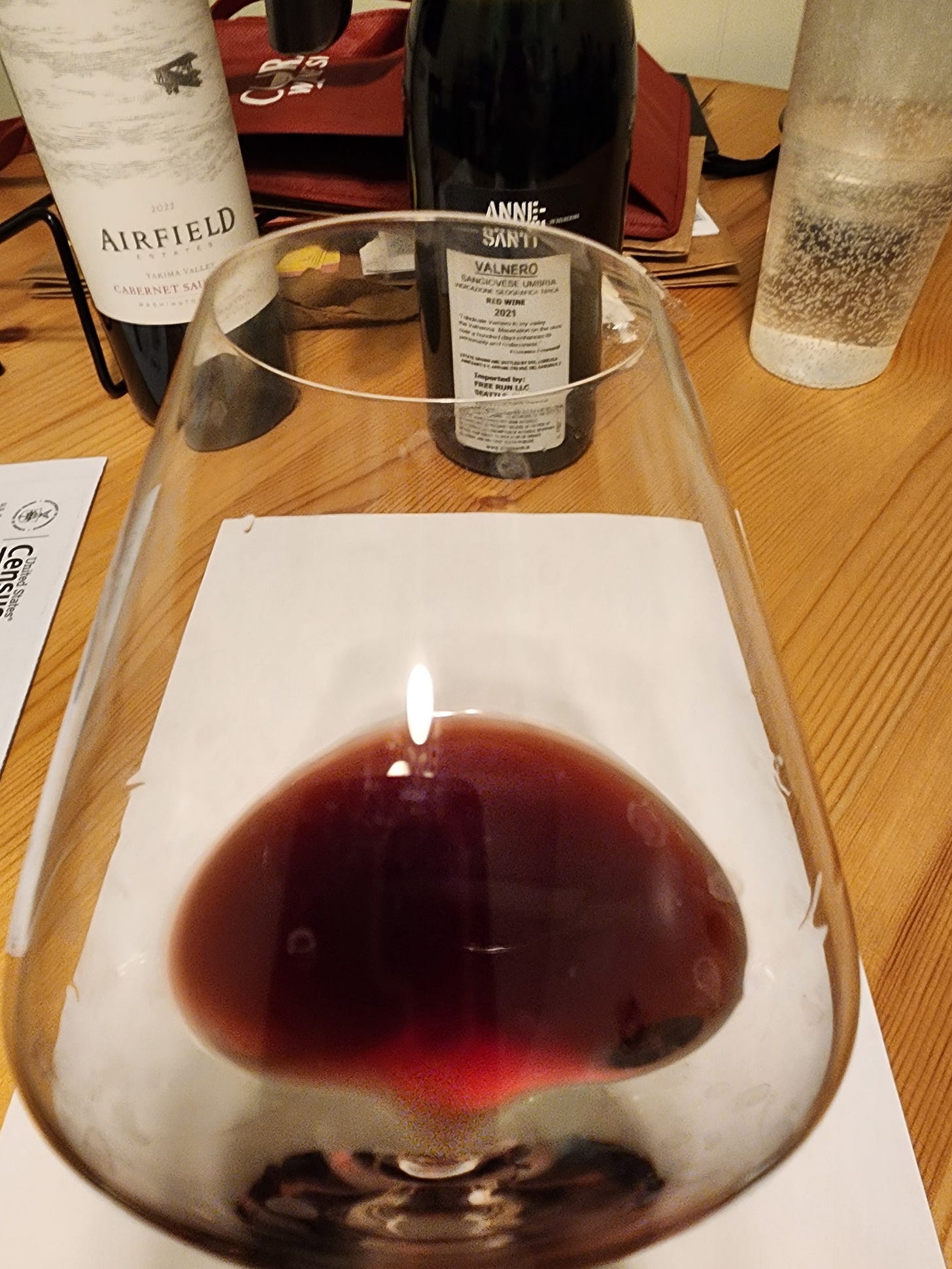Blending Lab #1: Marche vs. Paso + Umbria meets Yakima Valley
Two experiments in home wine blending - a new activity I hope to turn more wine appreciators on to!
I can’t take credit for this, even though I work at a place literally called The Blending Lab Winery.
But here on Substack, this genius idea was kickstarted by Tannic Panic!, their latest post of which dropped last week:
In thier post, they tried to blend a 100-point wine “from scratch”, or rather by blending two lesser 90+ point wines to theoretically fill in any missing gaps they had on their own.
They didn’t do half bad - they made it to 97 POINTS! (see article above for full details.)
Now I want to make this a semi-regular feature as well here on VINTERTAINMENT. It just so happened, I’d tried an odd blending experiment myself just the week before….
Marche vs. Paso Robles
I had gotten my hands ona red wine from the Marche region of Italy (not a region I’d ever seen before! I knew of it, but had never actually stumbled upon a wine from there.) This was a 50% Cab Sauv, 50% Petite Verdot blend. So sort of a Super Tuscan, but not from Tuscany. A Mega Marche!
I mentioned how I work at “The Blending Lab Winery”, which is a Paso Robles based winery (though I work in the LA tasting room) where we let customers blend their own wine with single varities made for that purpose. It happened that I had a Petite Verdot and a Cabeernet Sauvignon, so we made our own custom 50/50 blend of Cab and P.Verdot with Paso fruit!
How did they fare?
The Mega Marche was a 2015, so had some good age on it. The nose was astounding - very floral and fruity, spice, too. Just wonderful. The flavor was balanced and equally a medley of florals and fruit. But the finish was very short. You smacked your lips once and - poof! - it vanished.
The Paso blend was abyssmal. This Cab in no way was made for the Petite Verdot, holy cow. The Verdot was peppery and floral and black currant for days. The Cab was hot and ripe, red fruit and green pepper for days. The two together became unctuous, a fruit slop, with the alcohol suddenly far too noticeable.
That said, I brought along a Paso Zinfandel as well, which I had toyed around with the Petite Verdot before. We did a 50/50 of those and it was magnificent! The sweetness and solid acidity of the Zin complimented the pepper, flowers, and tannic tructure of the Verdot. That beat the Mega Marche. Though the Paso Petite Verdot on its own was probably the hands down winner.
It’s a really good Petite Verdot, yo.
Umbria Meets Yakima Valley (Washington)
Tannic Panic! tried blending a Super Tuscan with a Yakima Valley Cab Sauv.
I considered blending the exact same wines as they did (they’re both avilable at retailers like Total Wine, so it was likely a possibility.) And one day we may do a collab like that - in fact, we almost assuredly will if I have anything to say about it.
But I happened to already have a different Yakima Valley Cab Sauv. And had just received an Umbrian 100% Sangiovese! The bottle said the wine had been macerated on its skins for 100 days, which suggested it might have the robustness to stand up to a Washington Cab. And Sangiovese and Cab were often blended together in Super Tuscans, so…dammit, I had to try it!
NOTE: All scores are based on Tannic Panic’s system, which is the most robust points system I’ve yet encountered.
2022 Cabernet Sauvignon Yakima Valley, Washington (14.2% ABV)
Black cherry, herbaceous, hint of earth and baking spice. There’s a youthful brightness here - it’s only a 2022, after all! Medium acidity, silky tannins even at its young age. It could use more earthiness, more sweetness, more spice, all of which will likely come with additional age, but it ain’t here yet.
Score Breakdown: Balance 33/40 | Aroma/Flavor 16/20 | Concentration 13/15 | Length 13/15 | Complexity 8/10 = 83 points
2021 Anne-Santi “Valnero” Sangiovese, Umbria, Italy (12.5% ABV)
Strawberry, red cherry, respberry, low tannins. medium acidity, light body, transparent. So even with the 100 days of maceration, this is a light, delicate expression of Sangiovese. Mostly young and red fruity, with a touch of herbs and rose. Needs more
Score Breakdown: Balance 33/40 | Aroma/Flavor 17/20 | Concentration 10/15 | Length 10/15 | Complexity 7/10 = 77 points
The Blending Trials
Oof. Not off to the best start! Though note this scoring system is great because it allows for a “quite good” wine to be as low as 77 points. Which is how a 100-point scoring system SHOULD be!
So the Sangio is a bit too delicate, a bit too light and airy and two-note.
The Yakim Cab is a bit young, a bit fresh, but had more depth and tannin and alcohol. Is it enough to combine into something greater?
The 50/50 Blend
Perfumed, floral, rose and cherry, short finish, slightly sour aftertaste.
Yikes, the front palate on this blend is quite good, but quickly turns. Suddenly the finish is weak, and yet the aftertaste is neverless yucky. Let’s just to making one of these wines the significant lead in a blend to see if we can remedy this.
Score Breakdown: Balance 30/40 | Aroma/Flavor 12/20 | Concentration 12/15 | Length 11/15 | Complexity 7/10 = 72 points
The 25/75 Blend
25% Yakima, 75% Umbria
Adds touch of extra body, a hint of darker fruit to the very red and resh Umbrian, remains smooth. Muted nose, but best flavor.
Score Breakdown: Balance 34/40 | Aroma/Flavor 18/20 | Concentration 12/15 | Length 12/15 | Complexity 8/10 = 84 points
The 75/25 Blend
75% Yakima, 25% Umbria
NOPE.
(Okay, okay, a little more info than that: the whole flavor profile here is just out of whack. It’s gone sour, tart, bitter, hardly any sweetness or recognizable fruit. When it comes to blending, often you can predict the structural components - alcohol, acidity, tannins - but the flavor is often pure alchemy. It can change in ways that surprise, for better or for worse.
Score Breakdown: Balance 30/40 | Aroma/Flavor 8/20 | Concentration 12/15 | Length 12/15 | Complexity 6/10 = 68 points
Takeaways
This is sometimes how it goes! Blending is a crazy amount of fun but NOT always pleasant - you don’t always discover anything better than the two wines on their own.
These two wines seem to "sour" each other. I'm guessing it's the Umbrian Sangiovese that simply isn't made to be blended. Umbria isn't known for many single variety reds outside of Montefalco Sagrantino. So plainly they chose not to blend this specific Sangiovese, and for good reason. It doesn't (seem to) play well with others.
And th-th-th-that’s blending wine for you! Join us next time when we try to blend a few additional wines that may or may not make a lick o’ sense.
Have you ever blended wine at home? If so, what were the results?




